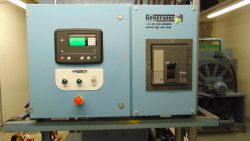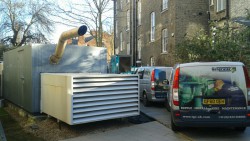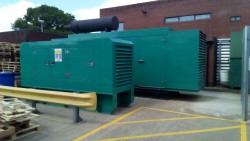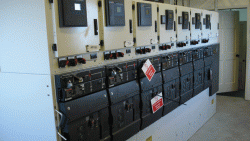2x800kVA & 1x600kVA New Back-up Generator System
An exciting two-year redevelopment project was undertaken at one of London’s internationally renowned private sector hospitals located in the South Kensington Area. The multi-million-pound Advance Programme has seen the upgrade of many areas of the hospital so it can continue to meet the changing demands of healthcare. This major redevelopment programme also included the upgrade of the entire site’s back-up generator system in order to provide the additional power necessary to accommodate the new state of the art equipment, new leading-edge technology and enhance patient rooms as well as the expansion of a number of areas offering specialised care.
This hospital delivers exceptional patient care and is already recognised as a centre for excellence in the fields of cardiology, oncology, paediatrics, complex surgery and medicine. It is therefore essential, in the event of a mains power outage, that the hospital’s back-up generator system will work seamlessly with the site’s power distribution architecture to continue to meet the power load of the hospital’s current and new facilities.
The Generator Company have carried out numerous back-up generator system projects at several major hospitals nationwide and we came highly recommended to this leading London hospital by an independent Consultant we worked with on one of them.
In brief, the project involved the removal of two existing generators from the basement, in plantrooms on level -2, the installation of two replacement generators and the addition of a third generator facilitating the integration of all three units, in separate plantrooms, into a common operating system.
The challenges were: Design and build three bespoke generators at The Generator Company’s Dover facility to meet the client’s specification.
- Design remote cooling systems for two generators requiring remote roof mounted radiators on Level 4.
- Design an internal acoustic housing solution for one generator to meet noise levels and avoid extensive and expensive modifications to the hospital’s building.
- Provide extensive off site and on site testing of new equipment.
- Devise a method to remove existing equipment from the basement which required breaking down the equipment and using bespoke lifting gear and techniques due to extreme restrictions on access.
- Using the same bespoke lifting gear and techniques to deliver the new equipment in “broken down” components and reassemble.
- Integrate and modify new equipment with existing equipment for a common operating system whilst keeping the Hospital live.
- Meeting the fire safety requirements as specified by the City of Westminster’s Fire Officer
- Devise a carefully coordinated program and sequence of operations to install the new equipment in phases in order to eliminate any disruptions to Hospital operations and processes.
- Provide a robust aftercare and maintenance program to maintain the equipment and the Hospital.
Our Project Manager liaised with the client and their Facilities Management [FM] team to enable us to put together a proposed new system to a very strict deadline and adhering to some very stringent stipulations.
We recommended replacing the two existing generators with a new back-up generator system which included 1 x 600kVA prime rated Volvo powered diesel generator with Newage alternator and 2 x 800kVA prime rated Perkins powered diesel generators with Newage alternators, together with a new LV switchboard scheme and common synchronised LV board.
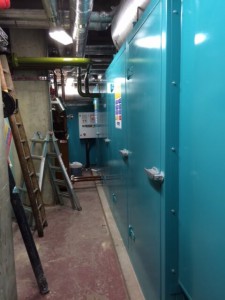 All three new generators include a DSE8610 generator control panel which will connect to a new LV board within the 3 main sub stations in the building, each having a DSE8660 mains control panel. The generators and LV boards will also connect to the new common synchronised LV board housing a DSE8003 Bus Tie control panel to enable all three of the generators to be seamlessly integrated, managed and controlled.
All three new generators include a DSE8610 generator control panel which will connect to a new LV board within the 3 main sub stations in the building, each having a DSE8660 mains control panel. The generators and LV boards will also connect to the new common synchronised LV board housing a DSE8003 Bus Tie control panel to enable all three of the generators to be seamlessly integrated, managed and controlled.
The installation of the three generators required intricate planning as it was not only essential that there was no disruption to the hospital buildings, its patients and the grounds but the strict deadlines were not to be missed. Our Project Manager liaised closely with the client to schedule and co-ordinate the installation works with the live site. Each generator would also need to be installed in a carefully planned sequence to ensure there would always be back-up generator power available if an emergency occurred.
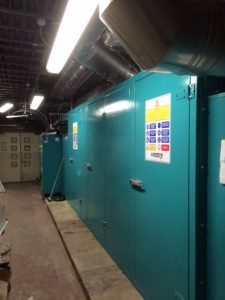 Once our proposed design and schedule of installation had been rigorously scrutinised and agreed by the client and their FM team we were able to commence progress on the bespoke manufacture of the first 800kVA back-up generator that would be a new addition, and the only generator to be housed within an acoustic enclosure. The project was allocated to us in September 2014 for the installation of the first generator in January 2015 with a completion date of June 2015. Our installation team was organised, briefed and prepared for the task ahead.
Once our proposed design and schedule of installation had been rigorously scrutinised and agreed by the client and their FM team we were able to commence progress on the bespoke manufacture of the first 800kVA back-up generator that would be a new addition, and the only generator to be housed within an acoustic enclosure. The project was allocated to us in September 2014 for the installation of the first generator in January 2015 with a completion date of June 2015. Our installation team was organised, briefed and prepared for the task ahead.
A heavy duty base was completed in the boiler room, in the basement, for the installation of the new 800kVA standby generator with enclosure. The works were carried out over a weekend by our team of installation engineers, utilising our own HIAB we delivered and offloaded the new 800kVA generator and associated equipment. With severe space restrictions, manoeuvrability of a completed generator set was impossible and therefore, as previously planned and agreed, the components of the generator set were dismantled by our installation team and lowered into the basement using a versa lift truck. With great precision, the outlet duct and ductwork, silencer and exhaust flue and the flat packed enclosure were also carefully lowered into the basement. All of the equipment was then skated into the boiler room where the generator and enclosure were re-assembled.
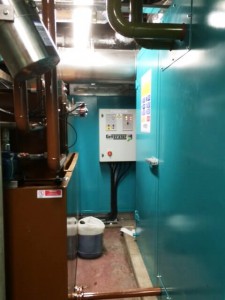 The new remote radiator was craned onto the roof into the allocated location and the team fitted the duct work from the generator enclosure to the roof outlet, as well as the new fuel pipe from the new bulk tank to the new day tank and new cooling pipe work from the generator to the remote radiator on the roof.
The new remote radiator was craned onto the roof into the allocated location and the team fitted the duct work from the generator enclosure to the roof outlet, as well as the new fuel pipe from the new bulk tank to the new day tank and new cooling pipe work from the generator to the remote radiator on the roof.
On completion of all the new pipe work and ducting the connection of the LV cables to the generator control panel, new LV board and new common synchronised board could be completed as well as the installation of the new fire suppression system. This completed the system set up for the first new 800kVA back-up generator set which we then commissioned so it could go on-line immediately in order to remove and replace the two existing site generators with our new ones. Our Project Manager had planned to remove the existing generators one after the other to ensure that the Hospital’s back-up generator power was never below its original capacity.
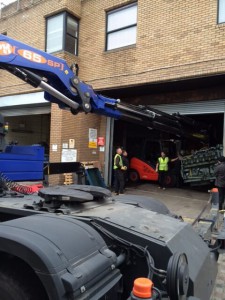 In turn, our engineers fastidiously removed the existing 660kVA and 437kVA sets and replaced with our new 800kVA and 600kVA generators. The installation of the new generators, as well as the removal of the old sets, were once again meticulously carried out like the first and again commissioned once each had been installed.
In turn, our engineers fastidiously removed the existing 660kVA and 437kVA sets and replaced with our new 800kVA and 600kVA generators. The installation of the new generators, as well as the removal of the old sets, were once again meticulously carried out like the first and again commissioned once each had been installed.
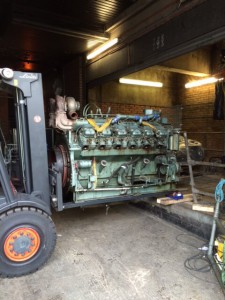 Each generator room required unique fire safety considerations which we included within each generator system set-up. It was requested by the Fire Officer for the City of Westminster to adhere to particular safety requirements. The fire suppression system we installed within each generator room comprised of 7 aerosol fire suppression units which have a combination of optical and ionisation detection. This means that in the event of a fire, smoke would be detected and a signal would be sent to the control panel. This would then operate a sounder and strobe after a pre-set time delay to allow occupants to evacuate as well as allowing dampers to fully close before sequentially activating the aerosol units within the area where the fire had been detected and thus extinguish the fire.
Each generator room required unique fire safety considerations which we included within each generator system set-up. It was requested by the Fire Officer for the City of Westminster to adhere to particular safety requirements. The fire suppression system we installed within each generator room comprised of 7 aerosol fire suppression units which have a combination of optical and ionisation detection. This means that in the event of a fire, smoke would be detected and a signal would be sent to the control panel. This would then operate a sounder and strobe after a pre-set time delay to allow occupants to evacuate as well as allowing dampers to fully close before sequentially activating the aerosol units within the area where the fire had been detected and thus extinguish the fire.
In addition to the above we also had to design a unique safety system in all three of the new bulk tanks and new free standing day tanks located in each generator room. The fuel system comprised of a transfer pump that was capable of transferring fuel from the bulk tank to the free standing day tank and then back again returning the fuel from the free standing day tank back to the bulk tank. This set up was required to reduce the fire risk when the generators were not in use. Therefore once the generators stopped working, they have the ability to dump all their fuel after ten minutes.
Following a very successful upgrade to the Hospital’s back-up generator system an integrated systems test was carried out which entailed a fully functional test of the entire system to prove that the generators and all the control software worked in accordance to their design specification.
A very rewarding project for The Generator Company meeting every deadline scheduled and all the design and installation specifications as set out by the client.
